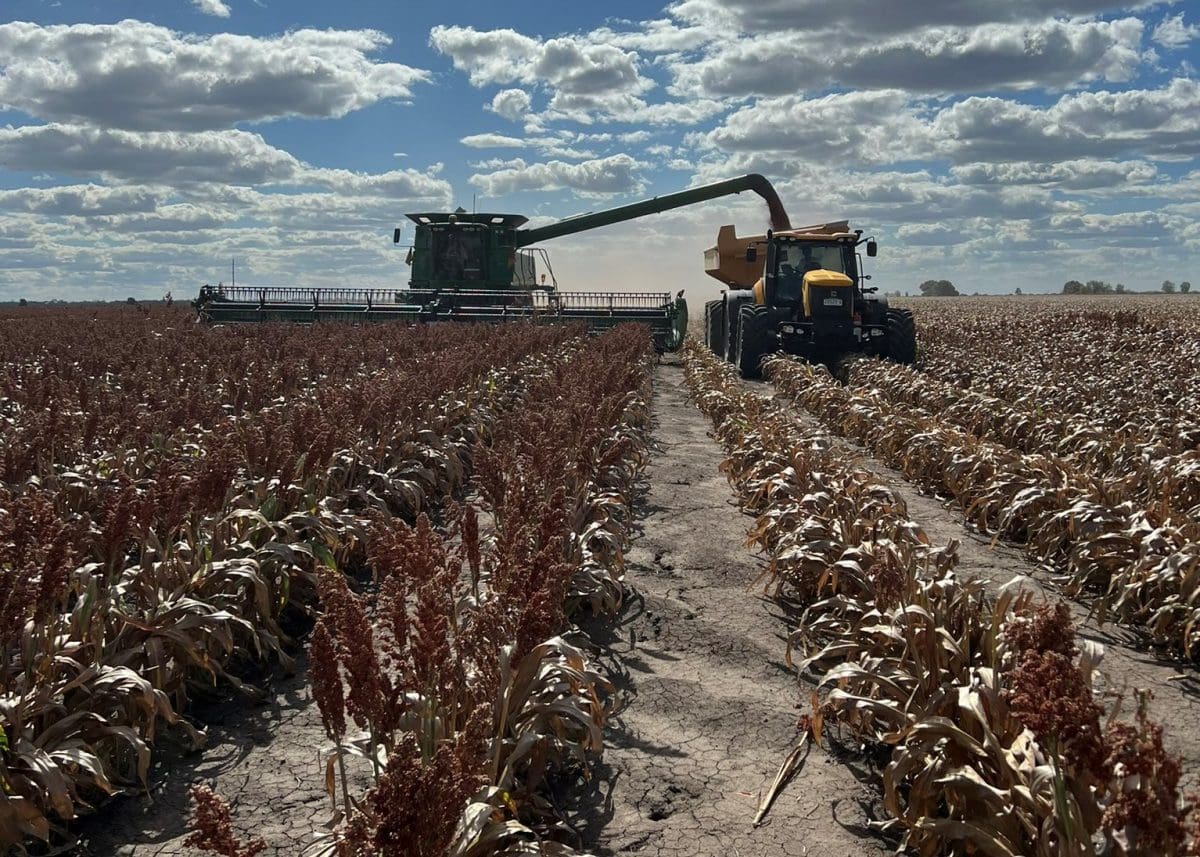
Harvesting sorghum in the Moree district. Photo: Andrew Uphill
ACCUMULATION of new-crop sorghum for export has seen its market lift by a few dollars this week, but feed barley and wheat prices have softened as domestic consumers settle into their ration mix for 2022.
As exports out of Victorian ports and Port Kembla in New South Wales hit maximum capacity, the focus on milling wheat, pulses and canola cargoes has reduced the exporter appetite in the near term for feed barley and downgraded wheat.
It means domestic consumers are getting a longer look at offers from growers and the trade, and SFW wheat appears to be increasing its share in domestic rations at the expense of barley.
However, factors as outlined in the USDA’s WASDE report released overnight point to the global market finding a floor, and Australia’s domestic consumers are advancing their coverage into the April-June quarter at current levels.
| Today | Feb 3 | |
| Barley Downs | $288 | $290 |
| SFW wheat Downs | $302 | $310 |
| Sorghum Downs | $295 | $292 |
| Barley Melbourne | $317 | $318 |
| ASW wheat Melbourne | $368 | $375 |
| SFW wheat Melbourne | $338 | $340 |
Table 1: Indicative delivered prices in Australian dollars per tonne.
Sorghum harvest ramps up
The harvest of sorghum in southern Queensland and northern New South Wales has accelerated in the past week under clear skies, and into a firming market as bulk accumulation starts and container exports continue at pace.
Trade sources report growers are pushing plenty out the gate straight off the header, and selling mostly weather-affected wheat to make space on farm to store what they are unable to truck out immediately.
“There’s still a bit of barley around, but growers aren’t selling it here in the north,” one trader said.
“They’re going more on to wheat.”
Some SFW wheat is being exported out of Newcastle and Port Kembla, NSW’s two bulk ports, and trade sources report China is among the export destinations stepping up on GP1, the grade between ASW and SFW.
Broun & Co director Charles Coventry said the weight of the big sorghum crop was likely to be felt in coming weeks.
“Sorghum’s just starting to build up some more momentum,” Mr Coventry said.
“There’s ample demand, but when you get into harvest, it can shift the dynamic a bit.”
Mr Coventry said northern wheat and barley markets have been drifting sideways, and consumers report they’ve stepped up their buying on increased offerings of SFW wheat in particular.
“Barley’s a little more scarce than wheat.”
Most stockfeed millers, including feedlots, are yet to complete their February-March coverage, and most have made a start on the next quarter.
“Some are covering out to June.”
Sources have said plenty of unpriced grain remains on farm, and consumers are as mindful of logistics as they are of price.
This is because trucks will soon be flat out carting sorghum to port and backloading with cropping inputs, and the availability of road freight to haul wheat and barley from farms to feedmills is expected to tighten.
South
Apart from some showers in South Australia, very little rain has fallen in the eastern Australian grainbelt in the past week.
Of concern on the weather front has been fires in the southern half of Western Australia’s Wheatbelt, which caused devastating damage on some farms and closed roads over the weekend.
However, with WA’s biggest ever winter crop safely harvested, and big stores of grain already at port or safely stored at up-country sites, no disruptions to exports or domestic consumers are expected.
Wilken Grain trader Andrew Kelso said growers in south-eastern Australia seemed to be keener to sell pulses, canola and milling wheat on rallies in the market, and were holding on to barley and downgraded wheat.
“It’s very quiet, and the market’s in a holding pattern,” Mr Kelso said.
“The domestic consumer seems to be keen to get a bit of barley, and anyone with higher-quality wheat booked has swapped to SFW.”
Trucks in the south are available now but are expected to be harder to book in coming months as growers jump on the tractor to plant their crops.
“All this SFW has to move to consumers or containers by truck, and trucks are going to be super busy.”

HAVE YOUR SAY